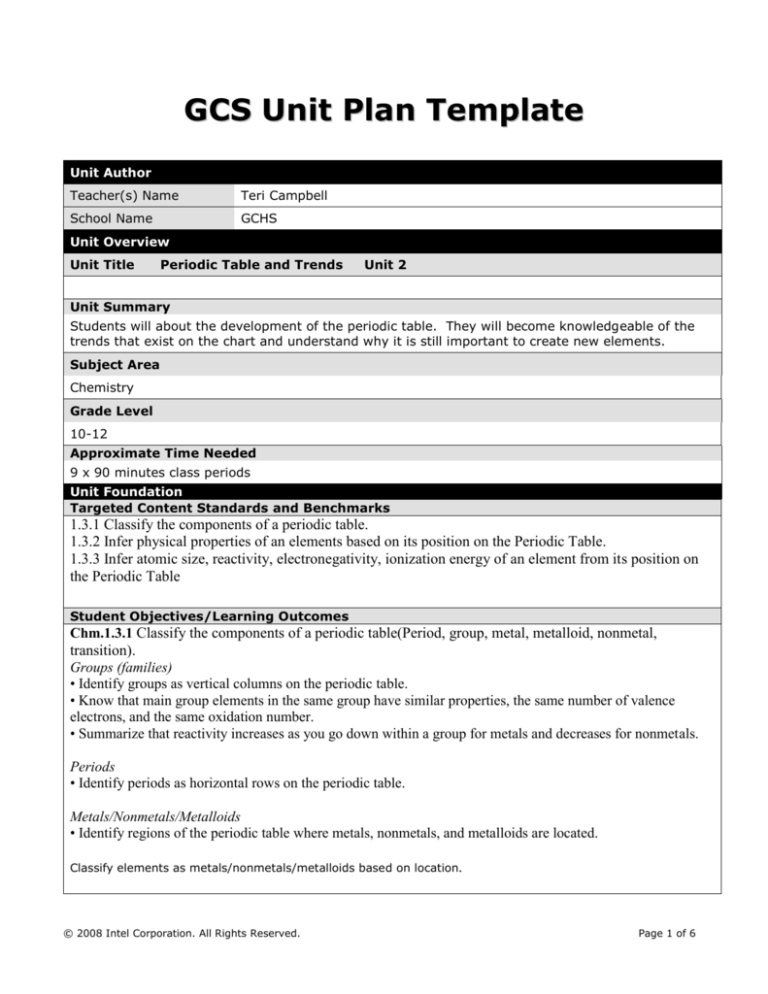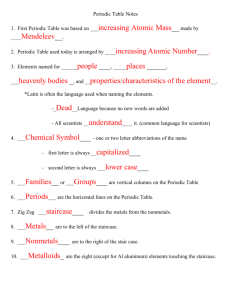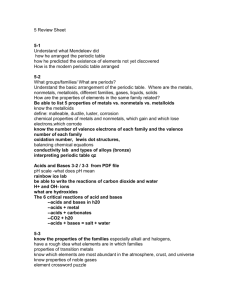
GCS Unit Plan Template
Unit Author
Teacher(s) Name
Teri Campbell
School Name
GCHS
Unit Overview
Unit Title
Periodic Table and Trends
Unit 2
Unit Summary
Students will about the development of the periodic table. They will become knowledgeable of the
trends that exist on the chart and understand why it is still important to create new elements.
Subject Area
Chemistry
Grade Level
10-12
Approximate Time Needed
9 x 90 minutes class periods
Unit Foundation
Targeted Content Standards and Benchmarks
1.3.1 Classify the components of a periodic table.
1.3.2 Infer physical properties of an elements based on its position on the Periodic Table.
1.3.3 Infer atomic size, reactivity, electronegativity, ionization energy of an element from its position on
the Periodic Table
Student Objectives/Learning Outcomes
Chm.1.3.1 Classify the components of a periodic table(Period, group, metal, metalloid, nonmetal,
transition).
Groups (families)
• Identify groups as vertical columns on the periodic table.
• Know that main group elements in the same group have similar properties, the same number of valence
electrons, and the same oxidation number.
• Summarize that reactivity increases as you go down within a group for metals and decreases for nonmetals.
Periods
• Identify periods as horizontal rows on the periodic table.
Metals/Nonmetals/Metalloids
• Identify regions of the periodic table where metals, nonmetals, and metalloids are located.
Classify elements as metals/nonmetals/metalloids based on location.
© 2008 Intel Corporation. All Rights Reserved.
Page 1 of 6
Representative elements (main group) and transition elements
• Identify representative (main group) elements as A groups or as groups 1, 2, 13-18.
• Identify alkali metals, alkaline earth metals, halogens, and noble gases based on location on periodic table.
• Identify transition elements as B groups or as groups 3-12.
Chm.1.3.2 Infer the physical properties (atomic radius, metallic and nonmetallic characteristics) of an element
based on its position on the Periodic Table.
Classify elements as metals/nonmetals/metalloids based on location.
Representative elements (main group) and transition elements
• Identify representative (main group) elements as A groups or as groups 1, 2, 13-18.
• Identify alkali metals, alkaline earth metals, halogens, and noble gases based on location on periodic table.
• Identify transition elements as B groups or as groups 3-12.
Electron configurations/valence electrons/ionization energy/electronegativity
• Write electron configurations, including noble gas abbreviations (no exceptions to the general
rules). Included here are extended arrangements showing electrons in orbitals.
• Identify s, p, d, and f blocks on Periodic Table.
• Identify an element based on its electron configuration. (Students should be able to identify elements
which follow the general rules, not necessarily those which are exceptions.)
• Determine the number of valence electrons from electron configurations.
• Predict the number of electrons lost or gained and the oxidation number based on the electron
configuration of an atom.
• Define ionization energy and know group and period general trends for ionization energy. Explain the
reasoning behind the trend.
• Apply trends to arrange elements in order of increasing or decreasing ionization energy.
Define electronegativity and know group and period general trends for electronegativity. Explain the reasoning
behind the trend.
• Apply trends to arrange elements in order of increasing or decreasing electronegativity
Chm.1.3.3 Infer the atomic size, reactivity, electronegativity, and ionization energy of an element from its
position on the Periodic Table.
Cross-Curricular Connections
Curriculum-Framing Questions
Why is organization important in science just as it is in life?
Essential
Question
Why do scientists continue to create new elements?
Why do you think the chart that contains the elements is called a “periodic”
chart or table?
Why has the arrangement of the periodic remained relatively unchanged for
the past 200 years?
Unit
Questions
Why was Mendeleev’s periodic table accepted over that of Lothar Meyer?
What is a trend?
What can the periodic table tell us about the general trends of atomic size,
ionization energy, electron affinity, and electronegativity?
© 2008 Intel Corporation. All Rights Reserved.
Page 2 of 6
What is a “rule of thumb”?
What is the definition of ionization energy and what affects does it have on the
behavior of an atom and it properties?
What is the definition of electron affinity and what affects does it have on the
behavior of an atom and it properties?
Content
Questions
What is the definition of electronegativty and what affects does it have on the
behavior of an atom and it properties?
How are metals and nonmetal different?
What is a period as it relates to the periodic table?
What is true of elements in a column i.e. group or family on the periodic table?
What is an electron configuration and how do they help us understand the
behavior of atoms?
Assessment Plan
Unit Details
Prerequisite Skills
Basic understanding of the use of the periodic chart. Differences between metals and nonmetals.
Instructional Procedures
Days 1 & 2
History of the periodic table (http://www.pbs.org/wgbh/nova/education/physics/developing-periodic-table.html)
Metal v. Nonmetals v. Semimetals
Families and other areas on the chart
(http://edutube.org/en/video/brainiac-alkali-metals)
Video on The Periodic Table
Day 3-5
Periodic Trends
-atomic radius
-ionic radius
-electronegativity
-ionization energy
honors compare 1st i.e. to 2nd
understand electron affinity
Days 6-8
Quantum Numbers Color chart
1- principle Learn to write configurations
2-sublevels 4- spin
3- orbital
Groups activity on quantum numbers
Day 9
Unit Test
Accommodations for Differentiated Instruction
© 2008 Intel Corporation. All Rights Reserved.
Page 3 of 6
Special Needs
Students/
Nonnative
Speakers
Preferred grouping, modified assignments, graphic organizers, enhanced
technology (including translation software), acknowledgement of
contributions of persons from various countries/nationalities
Gifted/Talented
Students
Drawing Lewis structures for elements
Materials and Resources Required For Unit
Technology – Hardware (Click boxes of all equipment needed)
X Interactive Technology
Computer(s)/iPads, etc.
X Student Response
System/Clickers
X Cell Phone
Video Camera
Printer
Digital Camera
Video Conferencing Equip.
X Projection System
X DVD Player
Document Camera
Scanner
X Internet
Other
X Television
Technology – Software (Click boxes of all software needed.)
Database/Spreadsheet
Image Processing
Desktop Publishing
Internet Web Browser
E-mail
Web Page Development
X Word Processing
X Multimedia
Other
X Web-Based Encyclopedia
Merrill & Prentice Hall Chemistry text
Current Science
Printed Materials
Worksheets Merrill and Prentice Hall
Chemistry Reference packet
Modified periodic table
Current Science on line
Supplies
© 2008 Intel Corporation. All Rights Reserved.
Page 4 of 6
Additional Unit Plan Information
Internet and Additional Resources
List additional resources for the lesson/unit plan or related lesson plans that map to the Common Core Standards in
the lesson/unit plan.
Common Core Standard
Resource
Page 5 of 6
Unit Plan Reflection
Describe any adaptations or “tweaks” to the resource or lesson plan that were needed:
No tweaks were needed. This unit went smoothly and according to schedule.
What do you plan to do differently the next time you teach this unit?:
The unit went well. Next time I will assign the element project to regular Chemistry. I did not assign it
this semester because I was trying to get back on schedule.
Page 6 of 6





